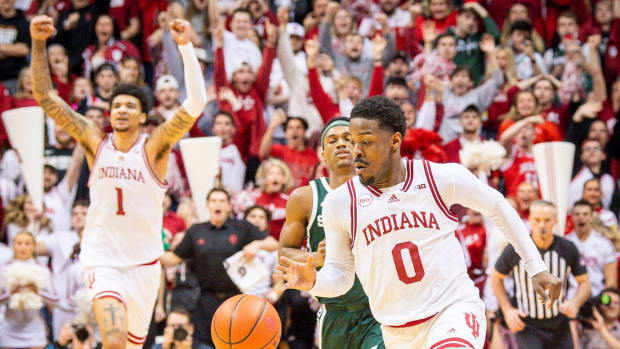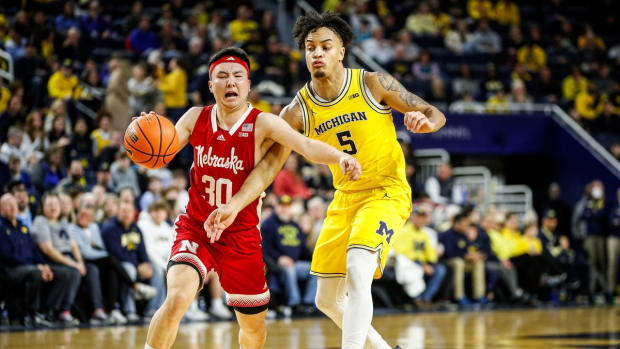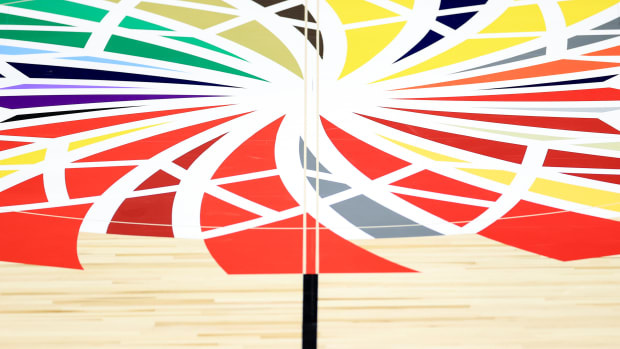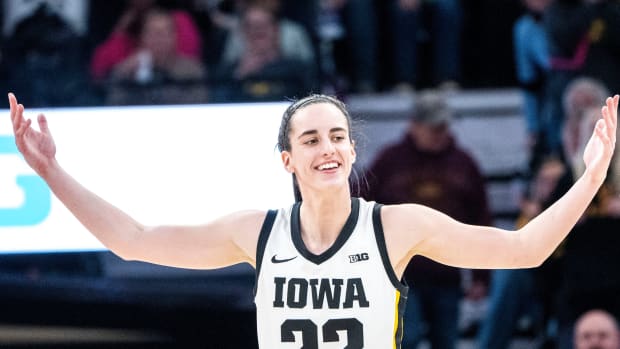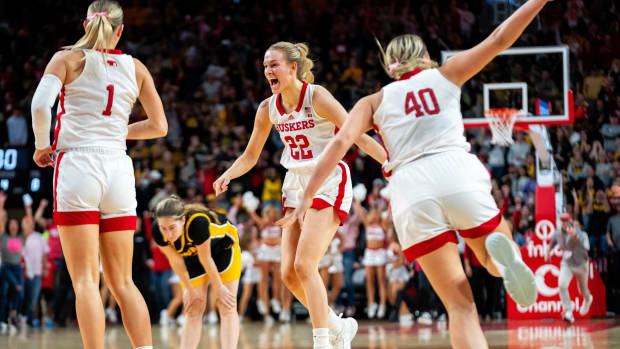Looking At Austin Davis' Climb, Previous Success Stories
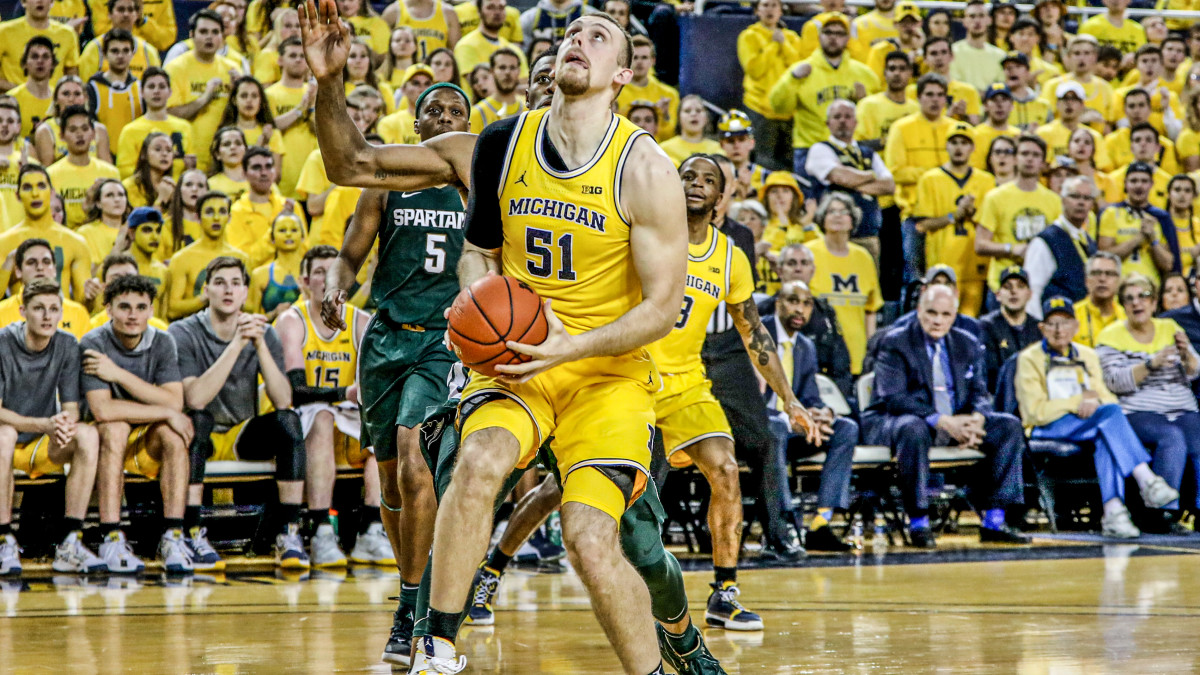
Redshirt junior big man Austin Davis has been playing the best basketball of his Michigan career this year and especially over the last several games. Over the last five contests, Davis is playing 10.6 minutes per game and is averaging seven points per outing. He's also been extremely efficient connecting on 15-of-16 shots in those games. He's provided a physical presence and has been a legitimate scoring threat when giving Jon Teske a break. Davis' success has been great to see and it makes you reminisce about how often we saw similar developments under former Michigan head coach John Beilein.
Dating back to the beginning of the Beilein Era, which started at Michigan in 2007, several players have thrived in a way that would definitely be considered success stories. Many examples of underrecruited, developmental prospects flourished under Beilein and set U-M hoops up in a way to achieve great success during his tenure and now under Juwan Howard. Here's a look back at some of the more noteworthy cases of guys outperforming expectations.
Zack Novak (2008-2012)
Coming out of high school Novak was a lowly three-star prospect and only had an offer from Valparaiso to go along with his tender from Beilein and the Wolverines.
Novak ended up playing in 134 games and starting in 122, both good for third all-time, and in those games played 4,357 minutes, which is a program record. He became the 28th player in program history to score 1,000 points and grab 500 rebounds in a career and served as a team captain three times.
At 6-5, Novak played power forward for Beilein and is often considered the poster child for resurrecting Michigan hoops under Beilein because of his passion, toughness and willingness to play all over the court. He helped Michigan return to the NCAA Tournament in 2009 after a 12-year absence and helped U-M win a Big Ten title in 2012, which was the first time in 26 years.
Stu Douglass (2008-2012)
Douglass' only other offer besides Michigan coming out of high school was from Western Michigan. The three star certainly didn't look like a potential Big Ten starter at 6-2, 180 pounds but he improved dramatically under Beilein and became more than dependable.
He played in 136 consecutive career games, which set the U-M record for games played in a career and knocked down 205 threes while at U-M, good for fifth all time.
Along with Novak, Douglass is often credited for getting Michigan basketball back to prominence and served as a team captain alongside Novak in 2012. He was also named U-M's most improved player and U-M's top defender after a successful senior season.
Jordan Morgan (2010-2014)
As a Detroit kid, it was easy for Morgan, a three-star prospect, to pick Michigan with just the Wolverines, Central Michigan, Oakland and Xavier to choose from. At 6-8, 245 pounds, Morgan was viewed as somewhat soft and not overly aggressive coming out of high school. While at Michigan he reshaped his body and became a legitimate force down low in a very physical Big Ten conference.
While at U-M he earned more than 15 team awards including the Wayman Britt Outstanding Defensive Player award, the Loy Vaught Rebounding Award, the Rudy Tomjanovich Most Improved Player Award and the Thad Garner Leadership Award all in 2014. He was named to the Big Ten All-Defensive Team by the coaches in 2013 and finished his career with a 63.10 career field goal percentage, which is best in program history. All of the questions about his body and toughness were answered in a big way while at U-M.
Tim Hardaway Jr. (2010-2013)
Surprisingly, Hardaway Jr. had just two offers coming out of high school — Michigan and Minnesota. The three-star prospect committed to the Wolverines in the summer of 2009 and the rest is history as he's now in the midst of a $71 million contract and his eighth year in the NBA. Hardaway's climb was so fast that he became the first player under John Beilein to leave for the NBA ahead of schedule. Hardaway played three years at U-M before declaring for the NBA to be drafted by the Knicks with the 24th pick of the first round.
While at Michigan, Hardaway averaged 14.3 points per game and really became a do-it-all wing. He knocked down the three at a 34-percent clip and grabbed nearly five rebounds per game. During his final season at U-M as a junior, Hardaway was recognized as an All-Big Ten first teamer by the coaches and an All-Big Ten second teamer by the media.
Trey Burke (2011-2013)
If Novak and Douglass are the poster boys for restoring Michigan basketball under Beilein, Burke is the poster boy for outperforming expectations under the long-time head coach.
Despite being from Columbus, Ohio, the Buckeyes did not offer, recruit or want the three-star Burke coming out of high school. He did have nine other offers to consider, including from Butler, Cincinnati, Iowa, Nebraska, Penn State and a few others, but Michigan proved to be a great choice for Burke.
In just two years at U-M, Burke lit the basketball world on fire. As a freshman he took home a ton of awards including Big Ten Freshman of the Year. He was also an honorable mention for the Associated Press All-America team and was an All-Big Ten second teamer according to the coaches and media. As a sophomore, which would be Burke's last year in Ann Arbor, he upped the ante in a big way. He led Michigan to a national title appearance and had several key plays during the run including a massive three pointer against Kansas to send the game into overtime and a would-be block against Peyton Siva and Louisville in the title game that inexplicably was called a foul. He was the consensus national player of the year according to most. To name a few, he was the John R. Wooden National Player of the Year, the Naismith National Player of the Year, the Oscar Robertson National Player of the Year, the Associated Press National Player of the Year and the Sports Illustrated National Player of the Year. He finished his Michigan career averaging 16.9 points per game and also dished out 5.7 assists per game.
He was picked ninth overall in the 2013 NBA Draft by the Minnesota Timberwolves but was ultimately traded on draft night to the Utah Jazz. After being named to the NBA All-Rookie First Team in 2014, Burke has bounced around the league a bit and was a member of the Philadelphia 76ers until being waived just nine days ago.
Spike Albrecht (2012-2016)
Despite being an undersized three-star prospect with just one offer coming out of high school, Albrecht played in all 39 games of his freshman season. He was just a bench player and only averaged 2.2 points per game, but he got off to a great start in Ann Arbor.
His claim to fame was the 2013 national title game against Louisville where he scored 17 points in the first half in relief of Trey Burke who was in foul trouble. He did it mostly from behind the three-point line going 4-for-5 from distance but also drove to the lane a couple of times and finished in traffic. Because of his heroic performance, he was named to the NCAA Final Four All-Tournament Team in 2013.
Spike never became a massive contributor at Michigan averaging just 3.9 points per game, but he became a leader, a dependable point guard and a fan favorite. He was a team captain in 2014-2015 and was the Bill Buntin Most Valuable Player in 2015.
Albrecht ended up transferring to Purdue for his final year of eligibility and finished his collegiate career as an outright Big Ten champion with the Boilermakers in 2017.
Caris Levert (2012-2016)
If anyone on this list can challenge Burke as the biggest success story it's probably Levert. As a very skinny and underdeveloped three-star prospect in high school, Levert reeled in offers from just Michigan, Ohio and Dayton. In fact, LeVert was originally an Ohio signee but was given his release from the Bobcat program after coach John Groce left for Illinois. That turned out to be a massive development for Beilein and the Wolverines.
Levert only started one game as a true freshman but turned a corner heading into year two. He started all 37 games that year and averaged a very solid 12.9 points per game. He was named the Rudy Tomjanovich Most Improved Player after that stellar sophomore season. His numbers continued to go up in year three (14.9 ppg) and four (16.5 ppg) but unfortunately played in just 35 games over his final two seasons due to injury. He finished his career at U-M averaging 10.4 points, 2.7 assists and 3.5 rebounds per game. Levert was an All-Big Ten second teamer from the coaches and media in 2014 and was a part of some very successful tourney teams at U-M.
Levert was drafted 20th overall by the Indiana Pacers in the 2016 NBA Draft but ended up a member of the Brooklyn Nets. He's now a regular starter for the Nets and as of his birthday last year, is under a three-year, $52.5 million contract with the team.
Muhammad Ali Abdur-Rahkman (2014-2018)
As a three-star prospect coming out of high school, Abdur-Rahkman was very much an afterthought for Beilein and Michigan. He didn't commit to the Wolverines until April of his graduating year and only had offers from Bucknell, George Mason, Rice and Robert Morris to go along with U-M.
Even though he wasn't viewed as a major target, MAAR got out of the gates quickly. He played in 29 games as a rookie and then became a full-time starter as a sophomore just before the Big Ten season tipped off. He would've started every single game during his final two years at U-M had there not been a miscommunication at the scorer's table against Maryland Eastern Shore in 2016. Still, he finished his U-M career playing in 144 games, which is good for the most all time.
He was a key part of some of the most successful programs in school history. He helped the Wolverines reach the 2017 and 2018 Sweet 16 and the Elite Eight in 2018. The Wolverines obviously played in a Final Four and the title game in 2018 as well. He was also instrumental in helping U-M win back to back Big Ten Tournament titles in 2017 and 2018. MAAR was a team captain for Michigan in 2017-18 and took home several team awards including the Bill Buntin Most Valuable Player award in 2018. He was a member of the NCAA All-West Regional All-Tournament Team in 2018 and finished his career as one of U-M's biggest fan favorites because of his humble beginnings, overall approach and knack for making a play when the Wolverines needed it.
Duncan Robinson (2015-2018)
Robinson will never be considered the most decorated Wolverine of all time but he definitely had the highest climb to get to his level of success.
There are no recruiting profiles to speak of for Robinson, which is why he started out at Division III Williams College. He was a star there, but making a jump to a Big Ten team was literally unprecedented. Robinson not only made the jump but did so in spectacular fashion to become one of the best shooters in college basketball and a regular starter for some very good U-M teams.
Robinson played in every possible game (115) while at U-M and was a real weapon from distance. He's eighth on U-M's all-time 3-point field goal percentage list after knocking down 237 three balls at a 41.9-percent clip. He was the Big Ten sixth-man of the year in 2018 after switching back and forth between the bench and starting five. He was also a Michigan captain in 2017-18 due in part to his approach and attitude as a starter who moved to the bench for the betterment of the team. He ended up starting 49 games at Michigan but was just as effective and perhaps more of a scoring weapon as a sixth man.
Robinson was not drafted but has since made a name for himself in the NBA with the Miami Heat. He reached 200 three pointers faster than anyone in NBA history doing so in just 69 games and will actually participate in the NBA All-Star Weekend three-point contest later tonight. He has since inked a $1.4 million contract as a regular contributor for the Heat and has started 49-of-54 games this year.
Jon Teske (2016-current)
Teske was either a three- or four-star recruit coming out of high school depending on where you looked but only had two additional offers from Dayton and Ohio State. After a freshman year at Michigan where he played a total of 61 minutes over the course of the entire season, people weren't sure if he'd ever be a regular contributor. Even as a sophomore he only started two games and still didn't look like a future starting big man in the Big Ten.
As a junior, however he started all 37 games and was widely regarded as one of the best bigs in the conference. He averaged 9.5 points and 7.0 rebounds per game last year and was a force on defense as well. His 75 blocks were sixth best all-time in a single season. Because of those numbers, he was named the Rudy Tomjanovich Most Improved Player last year and was also considered an honorable mention All-Big Ten performer.
The chapter isn't complete yet for this year but Juwan Howard has turned Teske into a back-to-the-basket true center and it looked like a great decision at the beginning of the year. Teske was the Battle 4 Atlantis All-Tournament Team and MVP and looked poised to breakout even more as a senior. He's been struggling as of late but is still posting career best numbers as a scorer (12.6 ppg) and a rebounder (7.6 rpg). His assists numbers are also up and his blocks are almost on pace with last year as he's already redirected 43 shots. How he finishes out this season will define his legacy but he's much better than people thought he'd be when he arrived at U-M.
Do you have a favorite from this list? Who do you think surpassed expectations the most? Comment below!!!

